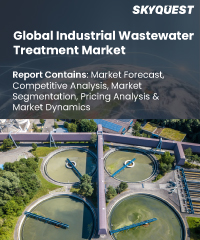
Report ID: SQMIG55D2003

Report ID:
SQMIG55D2003 |
Region:
Global |
Published Date: March, 2024
Pages:
182
|
Tables:
134 |
Figures:
77
Industrial Wastewater Treatment Market size was valued at USD 14.19 Billion in 2023 and is poised to grow from USD 14.94 Billion in 2024 to USD 22.6 Billion by 2032, growing at a CAGR of 5.30% during the forecast period (2025-2032).
Growing environmental concern about wastewater's impacts and an increase in the incidence of different chronic illnesses are two main factors influencing the growth of the industrial wastewater treatment industry. The demand for effective wastewater treatment has grown as a result of environmental concerns about soil degradation and the pollution of marine ecosystems and creatures. Additionally, wastewater serves as a vector for a number of chronic illnesses that are extremely detrimental to the environment and living things, including cholera, typhoid, diarrhea, amoebiasis, and others. According to the World Health Organization (WHO), 3.4 million people die from waterborne illnesses each year.
One of the biggest problems of the twenty-first century, according to the Office for the Coordination of Humanitarian Affairs (OCHA) of the United Nations (UN), is wastewater. The Centers for Disease Control and Prevention states that every year in the United States, infections spread through water cause over 7.2 million individuals to become ill. Several newer, more effective technologies have been used to help the problem. For instance, membrane filtering systems, sophisticated oxidation processes, and a few more cutting-edge techniques are employed to treat industrial wastewater.
Additionally, strict standards and regulations established by various governments in various nations are a significant component boosting the market's revenue growth. For instance, the UN Environment Programme started the Global Wastewater Initiative to promote effective wastewater management practices and try to shift people's perceptions of wastewater from being a waste product to being a highly valued resource. Additionally, to address the wastewater issue and raise awareness among decision-makers about the potential of wastewater as a resource, the World Bank supported the "Wastewater: From Waste to Resource" initiative throughout the area of Latin America and the Caribbean (LAC). Such government actions are having a favorable effect, driving up demand for industrial Wastewater Treatment and Wastewater Treatment Plants significantly (WWTPs).
US Industrial Wastewater Treatment Market is poised to grow at a sustainable CAGR for the next forecast year.
Our industry expert will work with you to provide you with customized data in a short amount of time.
REQUEST FREE CUSTOMIZATIONWant to customize this report? This report can be personalized according to your needs. Our analysts and industry experts will work directly with you to understand your requirements and provide you with customized data in a short amount of time. We offer $1000 worth of FREE customization at the time of purchase.

Report ID: SQMIG55D2003